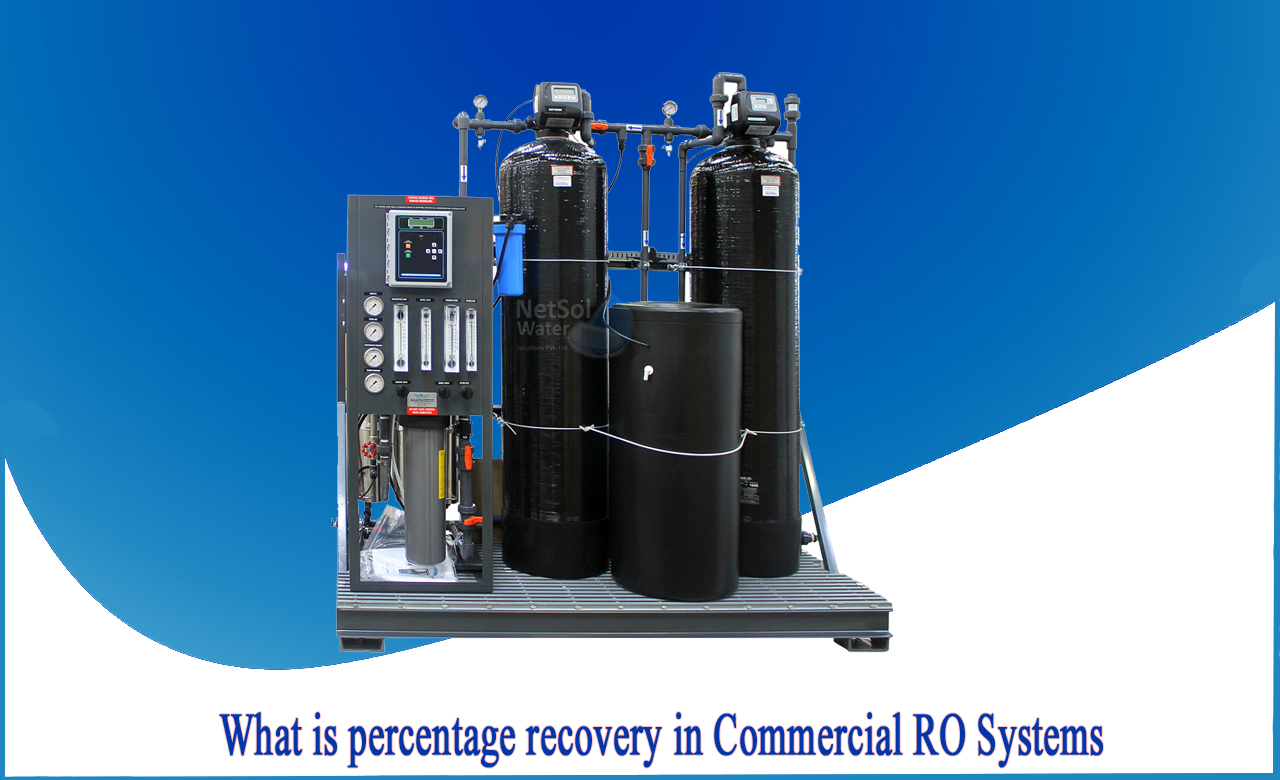What is percentage recovery in Commercial RO Systems?
Percent recovery is calculated by multiplying the ratio of ‘permeate flow rate’ to ‘feed flow rate’ by 100 percent. If other factors such as feed water TDS, operating pressure, and feed water temperature are constant, percent recovery and percent rejection are inversely related.
For example, membrane systems with 82 percent (%) recovery rate will convert 82 percent (%) of the total raw water input into treated permeate, while the remaining 18 percent (%) will be discarded as concentrate (or reject). Flow metres put in the permeate and concentrate pipe work are used to measure the recovery rate. Membrane systems are designed to operate at a specific flow and recovery rate and should not be used outside of these limits.
Calculation of recovery rate
Recovery R?ate is calculated as follows:
Percent (%) Recovery= {(Fc-Cf)/ Ff} x100
Where, Ff=Feed Flow in gpm.
Cf=Concentrate Flow in gpm.
For example, if your feed flow is 150 gpm and the permeate flow is 75 gpm, then the recovery is (75/150) x 100 = 50%.
How does Recovery Rate affect Membrane Treatment Systems?
1: Chemistry of feed water: The chemistry of the feed water determines the recovery rate of a membrane system. Ions including calcium, barium, strontium, fluorides, and sulphates, as well as other low-solubility chemicals like silica, can be found in natural well fluids. These substances will be concentrated in the concentrate (brine or reject) stream by the reverse osmosis process, where their concentrations may exceed their solubility limitations, causing precipitation.
Close to the membrane's surface, the maximum concentration of salts exists; (an action known as polarisation). Concentrations here may be 20% higher than in the bulk of the solution in the brine channel. This can cause crystals to develop on the membrane surface, resulting in a scale. A scaled membrane will have a high differential pressure, low permeate flow, and poor permeate quality. Pre-treating the raw feed water with scale inhibitors and/or additional chemicals is frequently required to obtain higher recovery rates without scaling.
2: Flux rate of membrane elements: The square footage of membrane surface determines the permeate production rate of a membrane system. As a result, the membrane flux rate is taken into account while designing a membrane system. This is calculated in gallons per day per square foot of membrane surface and is defined as the rate at which a specific membrane area can produce permeate. As a result, the membrane system's overall output capacity is proportional to the membrane area and thus the number of membrane elements.
An operator may be tempted to increase the membrane feed pressure to enhance permeate flow, but this would increase the flux rate, making the system more prone to fouling and necessitating more regular chemical cleaning. More membrane surface area is often required to boost the production of Reverse Osmosis (RO) system.
3: Control of train flow rate: A membrane system's recovery rate is controlled by a variety of controls. However, it is ultimately determined by the ratio of concentrate to permeate flow rates. The feed pump speed (which affects feed pressure), concentrate flow, permeate flow, and concentrate control valve position are all interdependent parameters on the train. Changing the settings of one of these will have an impact on the other.
These variables are linked, therefore changing the feed flow/pressure will affect the concentrate flow/pressure. The overall permeate flow is controlled by varying the feed flow/pressure by altering the feed pump VFD speed. Changing the location of the concentrate valve changes the concentration flow.
Because water temperature and TDS are relatively stable from day to day, there should be little variance in operating flow rates and pressures. Variations in feed temperature, feed TDS, and any membrane fouling may necessitate slight changes to the three system flow controls over time in order to preserve design specifications.
Are you looking for the best Industrial and Commercial RO Plant Manufacturers in India?
Through the use of extremely efficient reverse osmosis membranes, Netsol Water Solutions’ RO systems will remove undesired dissolved solids from your tap, brackish, or well water. Our system is the most valuable in the market, with less wastewater, low energy usage, high flow rates, and contaminant rejection at competitive costs. These systems contain dependable components and a solid design, as well as highly desirable features gleaned from years of experience manufacturing high-quality reverse osmosis systems.
Our RO water systems also offer the following benefits:
1: Carbon steel frame membranes from the most respected brands that are compact, heavy duty, and powder coated.
2: Long-term effectiveness.
3: Tested and proven (trouble-free operation).
4: Membrane fouling is kept to a minimum, which saves money.
5: Improvements in energy efficiency
You can always find useful information by liking and following us on YouTube and LinkedIn.
Contact us today on +91 9650608473 or email at enquiry@netsolwater.com to speak with a professional about water treatment or membrane treatment systems for your industry or company.



